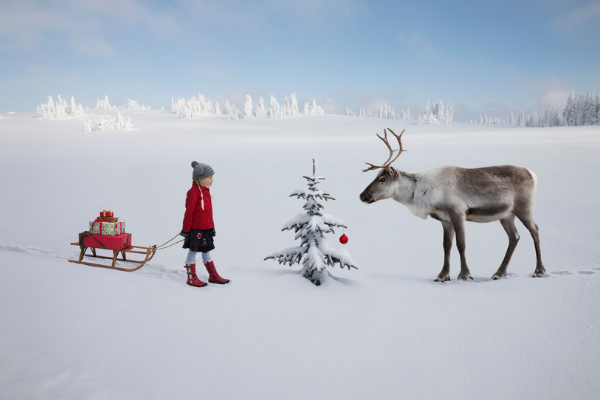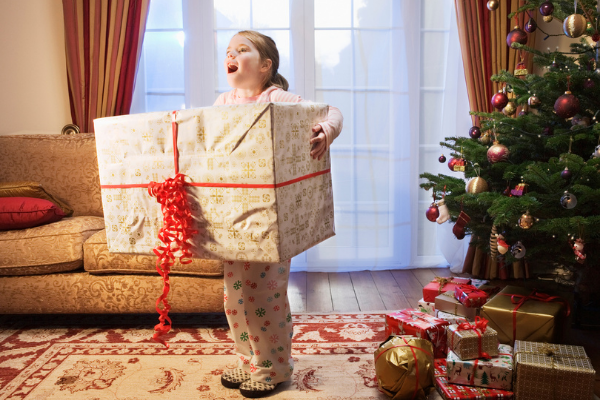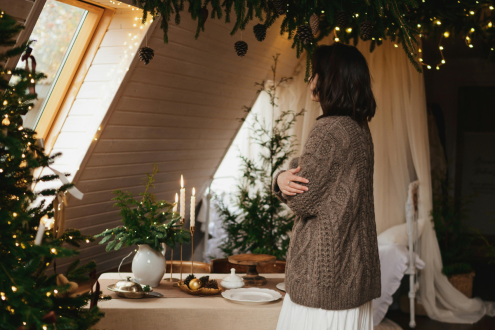How to talk to your kids about Santa (and other awkward Christmas conversations)
Few times of year throw up as many tricky topics as Christmas, from whether you-know-who is real to why there’s no PS5 under the tree. Heidi Scrimgeour, a mother of three, discovers how to tackle some challenging questions

Christmas seems to bring up some rather unnerving discussions in my house. I thought this might ease up as my children grew older, and once they were able to appreciate how heavily Santa relied upon my annual donations to the North Pole, but it turns out I was wrong.
In my experience at least, the awkward conversations you’d far rather wriggle out of don’t suddenly disappear once the Santa debate has been cleared up. With young adults come thornier festive issues – can the new girlfriend come over for Christmas dinner, can we ditch the silly stocking stuff and hand over a bit more cash and, by the way, we’re going out with our mates on Christmas Eve this year. (I once heard myself shriek, ‘But that’s when we watch Elf together!’ while brandishing a potato peeler in a not-altogether-festive fashion.)
The secret to navigating this part of parenting? Don’t avoid difficult conversations. Avoidance rarely works well in life, and especially not with kids. By allowing – and even encouraging – them to ask us difficult questions now, we make it more likely that they’ll come to us in the tricky moments of life that really matter.
To know that our children think of us as a soft place to land when life is hard makes this all worthwhile. So buckle up and prepare yourself for some open-hearted, candid Christmas chat, starting with the big one…
Is Santa real?
I panicked when my firstborn hit me with this. I’d already ballsed up the Easter Bunny question. (Let’s just say I was pulled aside by the nursery teacher and made to solemnly swear I wouldn’t wreck Christmas too.) Happily, I’ve since taken a smarter approach, turning tricky questions back to the kids.
 ‘Parents often dive in with an answer to this most common Christmas question, but you can save yourself so many headaches if, instead, you ask your child “what” and “how” questions,’ says therapist Ali Knowles. ‘Ask your child what they think about Santa. If they think he’s real, it means they still want to believe. If so, go with it, and don’t take away the magic prematurely. If they say they don’t think he’s real, ask why. Perhaps it’s because someone at school said so. Then ask how that makes them feel.’
‘Parents often dive in with an answer to this most common Christmas question, but you can save yourself so many headaches if, instead, you ask your child “what” and “how” questions,’ says therapist Ali Knowles. ‘Ask your child what they think about Santa. If they think he’s real, it means they still want to believe. If so, go with it, and don’t take away the magic prematurely. If they say they don’t think he’s real, ask why. Perhaps it’s because someone at school said so. Then ask how that makes them feel.’
Your child may feel that they need to keep believing for your sake and, if that’s the case, an honest conversation might make things easier for both of you.
Why didn’t Santa bring what I asked for?
Sometimes, Christmas Day is an exercise in disappointment for little people. ‘It can be incredibly frustrating to have your child upset or angry because they didn’t get one gift they wanted,’ says Natalie Costa, a children’s confidence coach. ‘Inside, you may be wondering if you’re raising an ungrateful child, and you might want to point out how many toys they already have.’ But instead of feeling upset, Costa recommends showing empathy and validating your child’s feelings. This helps them feel heard.
‘Recognise too that the emotional hub of your child’s brain is far more developed than the logical, rational part, so the disappointment feels really big,’ she says. ‘Help your child develop some self-soothing tools to aid them when they’re struggling with big feelings. Deep belly breathing, going for a walk or even scribbling out their anger on paper are simple ways to help them come back to calm. The more these techniques are practised in everyday life, the easier it will be for them to apply them when things feel really hard.’
When are we putting up the Christmas tree?
‘There are lots of practicalities to consider here, so it’s a good time to chat about your family traditions and why they exist,’ says Knowles. ‘Ask your child what it means to them to put it up now. They might say they’d feel Christmassy, so you could talk about what else you could do together to create that feeling – without risking the tree drying out by mid-month!’
Can we go to Lapland like they do on YouTube?
This is about reframing realistic celebrations, and that starts with chatting to kids about the traditions that matter to your family. I’ve found it useful to explain to my daughter that the YouTube families she follows are actually at work when they’re in Lapland making the rest of us feel like losers for not being able to afford a trip they haven’t even paid for! Once she began to see behind the veneer, a hot chocolate and a Christmas movie seemed to deliver all the festive feels that she had once imagined could only ever be found in the Arctic Circle.

Is the Elf on the Shelf really watching me?
‘All behaviour serves a purpose, which means there’s a reason behind every question your child asks,’ says Knowles. ‘My question back would be “What would it matter if he was?”. Don’t give kids all the answers: let them work things out. Your child might express concern that the elf will see them being naughty. You can point out that if he is watching, he’ll also notice all the good things they do too.’
Can I have a Christmas Eve box like my friends?
Try asking a child what’s so special to them about a box that is usually filled with a DVD and new pyjamas. ‘If the answer is that all their friends get one and they have nothing to talk about in the playground, that will open up a completely different conversation about their need to feel like they belong,’ says Knowles. ‘So many times we presume we know what a child is thinking and feeling based on our own experiences – and, if we’re honest, on our own fears. But often it turns out that we couldn’t be more wrong. It’s rarely as deep and complicated with kids.’
Why do we eat Christmas dinner when I hate it?
‘Don’t get into the why question – you’re only going to go in loops,’ advises Knowles. ‘Ask what bit of Christmas dinner they don’t like, and agree not to dish that up for them. You could also talk about a beloved family member who loves sprouts and explain that we have some of these things at Christmas because other people enjoy them, thereby making Christmas dinner about choice and inclusion rather than strict food rules.’
Is it really better to give than to receive?
This is a value I’ve tried to instil in my kids by encouraging them to buy Christmas gifts for each other. It backfired when my eldest bought an extravagant gift for his brother – who reciprocated with a pair of pants. Not even especially nice pants.
 It’s tempting to drive home the lesson that, despite what the TV adverts convey, Christmas isn’t all about receiving. But unless you’re prepared to referee Pantsgate, this is a dangerous game: ‘Christmas is a brilliant opportunity to teach our children about the value of giving and the impact of kindness,’ says Costa. ‘Encourage your child to reflect on a time they received a gift. How did they feel? Point out that we can pass on those lovely feelings to others – and we get a happiness boost as well!
It’s tempting to drive home the lesson that, despite what the TV adverts convey, Christmas isn’t all about receiving. But unless you’re prepared to referee Pantsgate, this is a dangerous game: ‘Christmas is a brilliant opportunity to teach our children about the value of giving and the impact of kindness,’ says Costa. ‘Encourage your child to reflect on a time they received a gift. How did they feel? Point out that we can pass on those lovely feelings to others – and we get a happiness boost as well!
‘Encourage your child to think about different ways they can show kindness throughout the festive season. Write down a few of these ideas and make time to complete them throughout the festive period. Remember to talk about the “happiness boosts” they will receive while doing it,’ she advises.
Why can’t I open every window on my Advent calendar on 1 December?
There are two schools of thought here. The first says this is the perfect opportunity to introduce kids to the idea of delayed gratification. The second says tell them to crack on – but recommend they do it stealthily by ripping off the back while no one is looking, in other words, make light and keep it fun!
‘Ask what makes them want to open every window now,’ says Knowles. ‘If it’s about the chocolate, you could suggest spending some pocket money on a bar of chocolate. But if it’s about excitement, you could agree to opening all the doors now, then putting away the chocolates to be dished out daily.’
Should I spend some of my pocket money on presents?
You’re never too young to start thinking of others… Great in theory, complicated in practice (see Pantsgate, above). ‘Try creating a “giving wish list” as a new family tradition,’ suggests Costa. Instead of thinking about what they want to receive, children can draw or write down gifts they’d like to give. This might mean spending some pocket money on small, thoughtful gifts, making a card or a homemade present or simply choosing toys they no longer use to donate to charity. What’s important is not the amount of money spent, but the thoughtfulness that is behind the gift, and the positive impact it will have on others and themselves.’
Photographs: Getty Images










